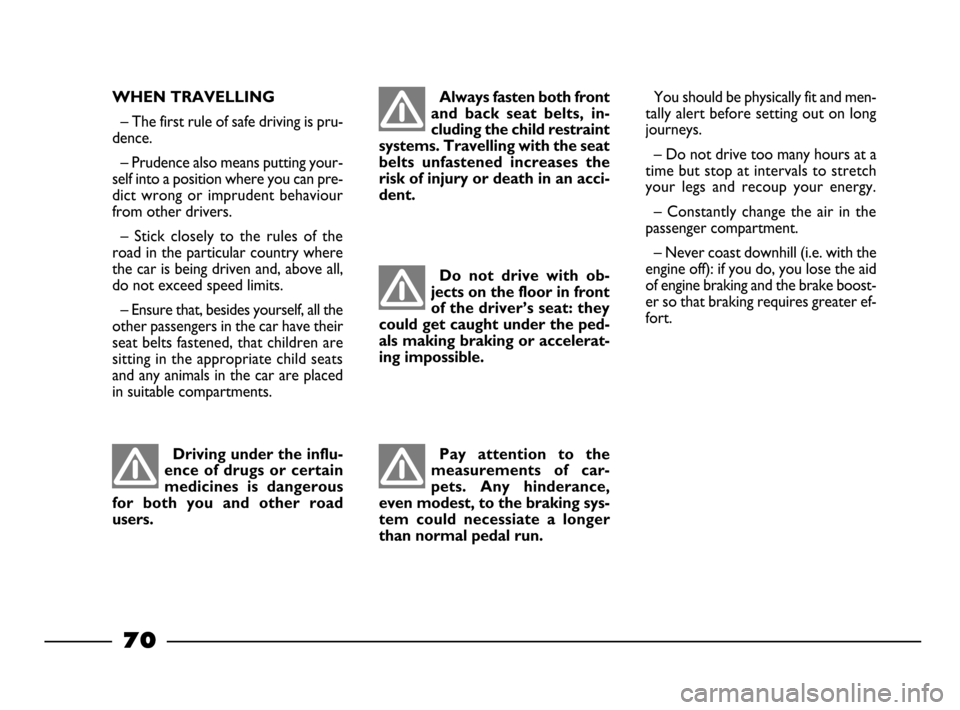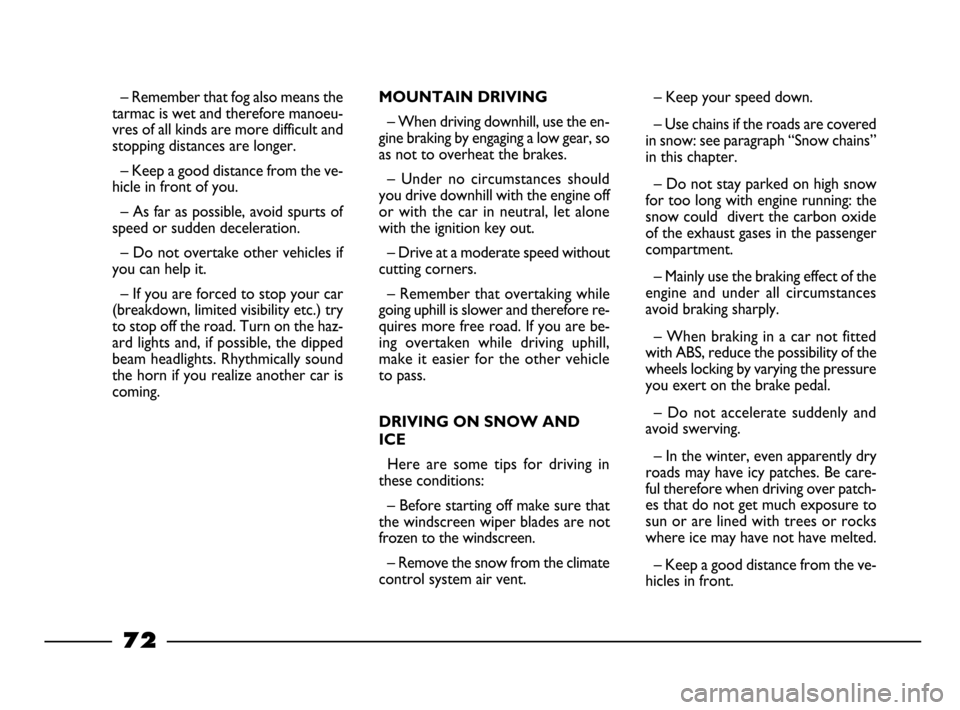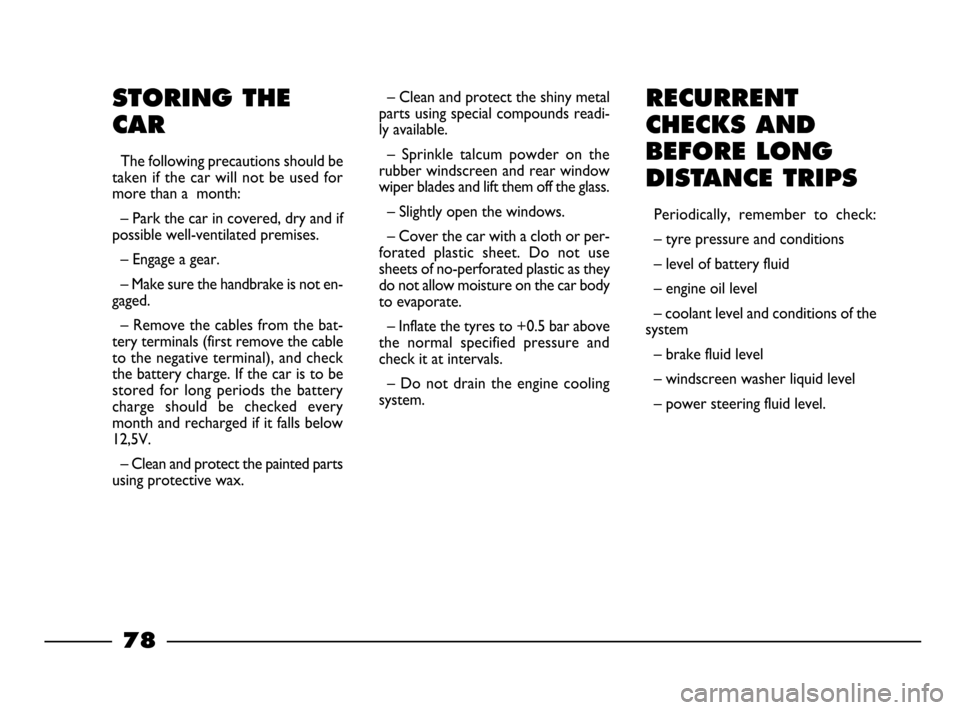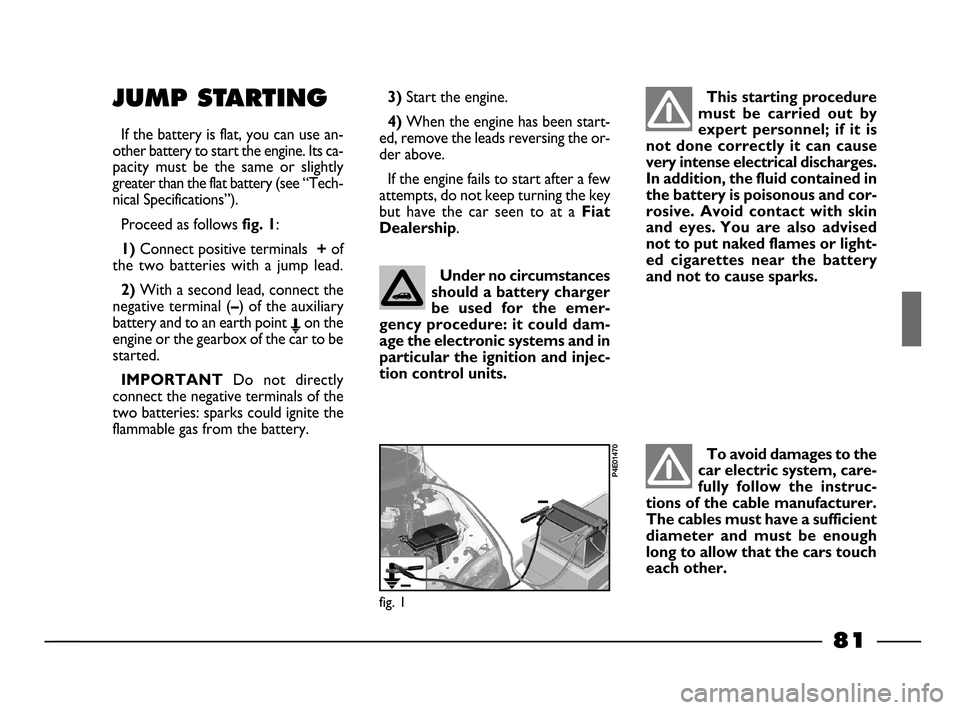engine FIAT PALIO 2003 178 / 1.G India Version Owner's Manual
[x] Cancel search | Manufacturer: FIAT, Model Year: 2003, Model line: PALIO, Model: FIAT PALIO 2003 178 / 1.GPages: 156, PDF Size: 6.27 MB
Page 68 of 156

67
With handbrake engaged and igni-
tion key at
MAR, the instrument pan-
el warning light
x
comes on.
To disengage the handbrake:
1)Slightly lift the handbrake and
press release button
A.
2)Keep the button pressed in and
lower the lever. Warning light
x
will
go out.
3)To prevent accidental movement
of the car, this procedure should be
carried out with the brake pedal
pressed down.
HANDBRAKE fig. 1
The handbrake lever is situated be-
tween the two front seats.
Pull the handbrake lever upwards un-
til the car cannot be moved. Four or
five clicks are generally enough when
the car is on level ground while nine
or ten may be required if the car is
on a steep slope or loaded.
IMPORTANTIf this is not the
case, take the car to a
Fiat Dealer-
ship
to have the handbrake adjusted.
Never leave unsuper-
vised children in the car.
Always remove the key
from the ignition switch and take
it with you when you get out of
the car.
fig. 1
P4E02046
PARKING
Stop the engine, engage the hand-
brake and engage first gear if the car
is faced uphill or reverse gear if it is
faced downhill in compliance with the
national Highway Code and leave the
wheels steered towards the road bor-
ders or the kerb. Block the wheels
with a wedge or a stone if the car is
parked on a steep slope.
Do not leave the ignition key at
MARbecause it drains the battery.
Always remove the key when you
leave the car.
64-79 03/03/2003 06:45 PM Page 67
Page 69 of 156

68
You must press the
clutch fully down to
change gear properly. It is
therefore essential that there is
nothing under the pedals. Make
sure that mats are lying flat and
do not get in the way of pedals.
SAFE DRIVING
In designing the Fiat Palio, Fiat made
every effort to offer a car able to pro-
vide driver and passengers with top
class levels of safety.
Nevertheless it is always the behav-
iour of the person at the wheel that
determines road safety.
Below you will find some simple tips
to help you travel in safety under dif-
ferent conditions.
You will no doubt be familiar with
many of them already but it will be
useful to read them all carefully.
USING THE
GEARBOX
To engage the gears, press the clutch
pedal fully down and put the gear lever
into one of the positions shown in the
diagram in
fig. 2(the diagram is also
on the gear lever knob).
To engage the reverse gear (
R), wait
that the car has stopped moving com-
pletely; from the neutral position, lift
the ring
Aof the reverse gear inhibitor
device, move the lever towards the
right side and then backwards.
fig. 2
P4E02289
IMPORTANTThe car can be put
into reverse gear when it has stopped
moving completely. With the engine
running, before engaging the reverse
gear, wait at least 2 seconds with the
clutch pedal fully down to prevent
damage and grating of the gears.
64-79 03/03/2003 06:45 PM Page 68
Page 71 of 156

70
WHEN TRAVELLING
– The first rule of safe driving is pru-
dence.
– Prudence also means putting your-
self into a position where you can pre-
dict wrong or imprudent behaviour
from other drivers.
– Stick closely to the rules of the
road in the particular country where
the car is being driven and, above all,
do not exceed speed limits.
– Ensure that, besides yourself, all the
other passengers in the car have their
seat belts fastened, that children are
sitting in the appropriate child seats
and any animals in the car are placed
in suitable compartments.
Driving under the influ-
ence of drugs or certain
medicines is dangerous
for both you and other road
users.
Always fasten both front
and back seat belts, in-
cluding the child restraint
systems. Travelling with the seat
belts unfastened increases the
risk of injury or death in an acci-
dent.
Do not drive with ob-
jects on the floor in front
of the driver’s seat: they
could get caught under the ped-
als making braking or accelerat-
ing impossible.
Pay attention to the
measurements of car-
pets. Any hinderance,
even modest, to the braking sys-
tem could necessiate a longer
than normal pedal run.
You should be physically fit and men-
tally alert before setting out on long
journeys.
– Do not drive too many hours at a
time but stop at intervals to stretch
your legs and recoup your energy.
– Constantly change the air in the
passenger compartment.
– Never coast downhill (i.e. with the
engine off): if you do, you lose the aid
of engine braking and the brake boost-
er so that braking requires greater ef-
fort.
64-79 03/03/2003 06:45 PM Page 70
Page 73 of 156

72
– Remember that fog also means the
tarmac is wet and therefore manoeu-
vres of all kinds are more difficult and
stopping distances are longer.
– Keep a good distance from the ve-
hicle in front of you.
– As far as possible, avoid spurts of
speed or sudden deceleration.
– Do not overtake other vehicles if
you can help it.
– If you are forced to stop your car
(breakdown, limited visibility etc.) try
to stop off the road. Turn on the haz-
ard lights and, if possible, the dipped
beam headlights. Rhythmically sound
the horn if you realize another car is
coming.MOUNTAIN DRIVING
– When driving downhill, use the en-
gine braking by engaging a low gear, so
as not to overheat the brakes.
– Under no circumstances should
you drive downhill with the engine off
or with the car in neutral, let alone
with the ignition key out.
– Drive at a moderate speed without
cutting corners.
– Remember that overtaking while
going uphill is slower and therefore re-
quires more free road. If you are be-
ing overtaken while driving uphill,
make it easier for the other vehicle
to pass.
DRIVING ON SNOW AND
ICE
Here are some tips for driving in
these conditions:
– Before starting off make sure that
the windscreen wiper blades are not
frozen to the windscreen.
– Remove the snow from the climate
control system air vent. – Keep your speed down.
– Use chains if the roads are covered
in snow: see paragraph “Snow chains”
in this chapter.
– Do not stay parked on high snow
for too long with engine running: the
snow could divert the carbon oxide
of the exhaust gases in the passenger
compartment.
– Mainly use the braking effect of the
engine and under all circumstances
avoid braking sharply.
– When braking in a car not fitted
with ABS, reduce the possibility of the
wheels locking by varying the pressure
you exert on the brake pedal.
– Do not accelerate suddenly and
avoid swerving.
– In the winter, even apparently dry
roads may have icy patches. Be care-
ful therefore when driving over patch-
es that do not get much exposure to
sun or are lined with trees or rocks
where ice may have not have melted.
– Keep a good distance from the ve-
hicles in front.
64-79 03/03/2003 06:45 PM Page 72
Page 74 of 156

73
ECONOMICAL
RUNNING THAT
RESPECTS THE
ENVIRONMENT
Environmental protection has been
one of the guiding principles in the
production of the Fiat Palio.
It is no accident that its pollution
control equipment is much more ef-
fective than that required by current
legislation.
Nonetheless, the environment can-
not get by without a concerted effort
from everyone.
By following a few simple rules you
can avoid harming the environment
and often cut down fuel consumption
at the same time.
On this subject, a few useful tips have
been given below to supplement those
marked by symbol #
, at various points
of the handbook.
You are asked to read both the for-
mer and the latter carefully.
DRIVING WITH ABS
The ABS is a braking system that es-
sentially offers two advantages:
1)It prevents wheel lock and con-
sequent skidding in emergency stops,
particularly when the road does not
offer much grip.
2)It makes it possible to brake and
steer at the same time so you can
avoid unexpected obstacles and direct
the car where you want while braking.
The extent to which this can be done
will depend on the physical limits of
the tyre’s sideways grip.
To exploit the ABS at best:
– During emergency stops or when
grip conditions are poor, you will feel
a slight pulsation on the brake pedal.
This is the sign that the ABS is work-
ing. Do not release the brake pedal but
continue to press so as not to inter-
rupt the braking action.– ABS prevents the wheels from lock-
ing but it does not increase actual grip
conditions between tyre and road.
Therefore, even if your car is fitted
with ABS, respect the safety distance
from the car in front of you and keep
your speed down when driving into
bends.
The ABS serves to increase your
control over the car, not to enable
you to go faster.
Warning light >, with
the engine running, nor-
mally indicates a faulting
the ABS system only. In this case,
the braking system is still effi-
cient, though without the an-
tilocking device. You are advised
to go immediately to the nearest
Fiat Dealership, driving in a man-
ner to avoiding sharp braking and
get the system checked.
64-79 03/03/2003 06:45 PM Page 73
Page 75 of 156

74
If the engine begins to “lose its
smoothless” when travelling, continue
your journey but reduce the demands
you are making on the engine and go
to a
Fiat Dealership as soon as you
can.
When the instrument panel fuel re-
serve warning light comes on, fill up as
soon as possible. A low level of fuel
can cause an uneven supply of fuel to
the engine with the inevitable increase
in the temperature of the exhaust gas
and serious damage to the catalytic
converter.
Never run the engine with one or
more spark plugs disconnected, even
for testing purposes.
Do not warm up the engine by letting
it idle for a while before moving off un-
less the outside temperature is very low
and, even in this case, only do so for less
then 30 seconds.Do not install other heat shields and
do not remove those already fitted to
the catalytic converter and exhaust
pipe.
Do not allow anything to be sprayed
onto the catalytic converter, lambda
sensor and exhaust pipe.
Ignoring the above rules
may lead to fire.
The catalytic converter
develops high tempera-
ture during normal oper-
ation. Do not park the car on
grass, dry leaves, pine needles or
other flammable material: fire
hazard
LOOKING AFTER EMISSION
CONTROL DEVICES
The correct use of pollution control
devices not only ensures respect for
the environment but also has an effect
on the car’s performance.
Keeping these devices in good con-
dition is therefore a fundamental rule
for driving that is easy on your pock-
et and on the environment too.
The first step to take is to follow the
Service Schedule to the letter.
Use only unleaded petrol.
If you have trouble starting, do not
keep turning the ignition key for long
periods. Be especially careful to avoid
bump starting the car by pushing, tow-
ing or rolling downhill: these are all
manoeuvres that can damage the cat-
alytic exhaust. Use an auxiliary battery
for start-ups only (see “Starting with
auxiliary battery” in the chapter “In an
emergency”).
64-79 03/03/2003 06:45 PM Page 74
Page 77 of 156

76
Climate control system
The climate control system is an ad-
ditional load which greatly effects the
engine leading to higher(up to +20%
in average) fuel consumption. When
the temperature outside allows, use
the air vents where possible.
Spoilers
The use of optional extras, which are
not certified for specific use on the car,
may reduce the aerodynamic pene-
tration of the car and increase con-
sumption.
DRIVING STYLE
Starting
Do not warm the engine when the
car is stationary or at high or low revs:
in this way the engine will warm up
gradually increasing consumption and
emissions. You should drive off slow-
ly straight away avoiding high revs so
that the engine will warm up more
quickly.
Unnecessary actions
Avoid revving the engine when
stopped at traffic lights or before
switching off the engine and avoid
doubling the clutch as these actions
serve no purpose in modern cars and
only increase consumption and pollu-
tion.
Gear selections
As soon as the traffic and road con-
ditions allow it, shift to a higher gear.
Using a lower gear to liven up accel-
eration greatly increases consumption.
In the same way, improper use of the
higher gears will increase consump-
tion, emissions and wear and tear on
the engine.
Top speed
Fuel consumption increases consid-
erably as speed increases. For exam-
ple, when accelerating from 90 to 120
km/h, fuel consumption increases up
to approximately +30%. Your speed should be kept as even
as possible and superfluous braking
and acceleration avoided as this in-
creases both consumption and emis-
sions. A “smooth” driving style should
be adopted by attempting to anticipate
manoeuvres to avoid imminent danger
and to keep a safe distance from the
vehicle in front to avoid braking
sharply.
Acceleration
Accelerating violently increasing the
revs will greatly effect consumption
and emission; acceleration should be
gradual and not exceed the maximum
torque.
CONDITIONS OF USE
Cold starting
Very short distances and frequent
cold starting will not enable the engine
to reach optimal running temperature.
It follows, therefore, that consumption
will be higher (from +15 to +30% in
towns) as will the production of toxic
emissions.
64-79 03/03/2003 06:45 PM Page 76
Page 78 of 156

Type of snow chain
to be used
Reduced clearance snow
chains maximum projection off
wheel equal to 12 mm
Versions
1.2 EL-ELX-SPORT
1.6 16V GTX
1.9 EL-ELX
Tyres on which chains
can be fitted
165/80 R13
175/65 R14
165/80 R13
77
Traffic and road conditions
Heavy traffic and higher consumption
are synonymous: for example, when
driving slowly with frequent use of
lower gears or in towns where there
are numerous traffic lights.
Winding roads, mountain roads and
bumpy roads also have a negative effect
on consumption.
Enforced halts
During prolonged stops (traffic lights,
level crossings, etc.) the engine should
be switched off.
SNOW CHAINS
The use of snow chains is regulated
by the legislation in force in the coun-
try the car is driven in.
The chains may only be applied to
the drive wheel tyres (front wheels).
Refer to the following
table for information on
the wheels where snow
chains can be fitted. Follow the
prescriptions.
Check the tautness of the chains af-
ter driving some ten metres.
Keep your speed
down when snow
chains have been
fitted. Do not exceed 50 km/h.
Avoid potholes, do not mount
steps or kerbs and do not travel
long stretches on snow-free roads
otherwise you risk damaging
both your car and the tarmac.
64-79 03/03/2003 06:45 PM Page 77
Page 79 of 156

78
RECURRENT
CHECKS AND
BEFORE LONG
DISTANCE TRIPS
Periodically, remember to check:
– tyre pressure and conditions
– level of battery fluid
– engine oil level
– coolant level and conditions of the
system
– brake fluid level
– windscreen washer liquid level
– power steering fluid level.
STORING THE
CAR
The following precautions should be
taken if the car will not be used for
more than a month:
– Park the car in covered, dry and if
possible well-ventilated premises.
– Engage a gear.
– Make sure the handbrake is not en-
gaged.
– Remove the cables from the bat-
tery terminals (first remove the cable
to the negative terminal), and check
the battery charge. If the car is to be
stored for long periods the battery
charge should be checked every
month and recharged if it falls below
12,5V.
– Clean and protect the painted parts
using protective wax.– Clean and protect the shiny metal
parts using special compounds readi-
ly available.
– Sprinkle talcum powder on the
rubber windscreen and rear window
wiper blades and lift them off the glass.
– Slightly open the windows.
– Cover the car with a cloth or per-
forated plastic sheet. Do not use
sheets of no-perforated plastic as they
do not allow moisture on the car body
to evaporate.
– Inflate the tyres to +0.5 bar above
the normal specified pressure and
check it at intervals.
– Do not drain the engine cooling
system.
64-79 03/03/2003 06:45 PM Page 78
Page 82 of 156

81
JUMP STARTING
If the battery is flat, you can use an-
other battery to start the engine. Its ca-
pacity must be the same or slightly
greater than the flat battery (see “Tech-
nical Specifications”).
Proceed as follows
fig. 1:
1)Connect positive terminals +of
the two batteries with a jump lead.
2)With a second lead, connect the
negative terminal (
–) of the auxiliary
battery and to an earth point E
on the
engine or the gearbox of the car to be
started.
IMPORTANTDo not directly
connect the negative terminals of the
two batteries: sparks could ignite the
flammable gas from the battery.
3)Start the engine.
4)When the engine has been start-
ed, remove the leads reversing the or-
der above.
If the engine fails to start after a few
attempts, do not keep turning the key
but have the car seen to at a
Fiat
Dealership
.
fig. 1
P4E01470
This starting procedure
must be carried out by
expert personnel; if it is
not done correctly it can cause
very intense electrical discharges.
In addition, the fluid contained in
the battery is poisonous and cor-
rosive. Avoid contact with skin
and eyes. You are also advised
not to put naked flames or light-
ed cigarettes near the battery
and not to cause sparks.
Under no circumstances
should a battery charger
be used for the emer-
gency procedure: it could dam-
age the electronic systems and in
particular the ignition and injec-
tion control units.
To avoid damages to the
car electric system, care-
fully follow the instruc-
tions of the cable manufacturer.
The cables must have a sufficient
diameter and must be enough
long to allow that the cars touch
each other.
80-103 03/03/2003 06:49 PM Page 81